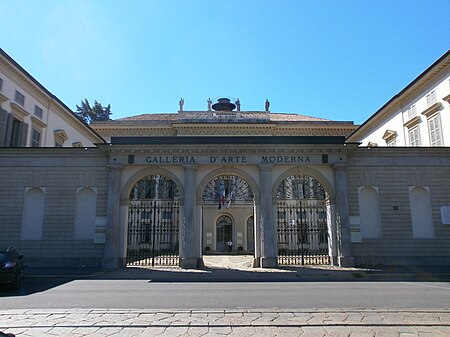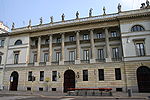Galleria d'Arte Moderna, Milan

The Galleria d'Arte Moderna ("modern art gallery") is a modern art museum in Milan, in Lombardy in northern Italy. It is housed in the Villa Reale, at Via Palestro 16, opposite the Giardini Pubblici. The collection consists largely of Italian and European works from the 18th to the 20th centuries.The museum has works by Francesco Filippini, Giuseppe Ferrari, Giovanni Fattori, Silvestro Lega, Giovanni Boldini, Vincent van Gogh, Édouard Manet, Paul Gauguin, Paul Cézanne, Pablo Picasso, Giacomo Balla, Umberto Boccioni, Francesco Hayez, Giovanni Segantini, Giuseppe Pellizza da Volpedo and Antonio Canova, among others. It has received donations from Milanese families including Treves, Ponti, Grassi and Vismara. After the Second World War the twentieth-century works in the collection were moved to the Padiglione d'Arte Contemporanea, built in 1955 on the site of the former stables of the palace, which had been destroyed by wartime bombing.In 2011 some works were moved to the Museo del Novecento; these included Bambina che corre sul balcone by Giacomo Balla (1912), Uomo che dorme by Renato Guttuso (1938) and The Fourth Estate by Pellizza da Volpedo (1901). In recent years the Modern Art Gallery has started a parallel program of temporary exhibitions, including a solo presentation of Tino Sehgal and a selection of drawings from the UBS Art Collection curated by Francesco Bonami.
Excerpt from the Wikipedia article Galleria d'Arte Moderna, Milan (License: CC BY-SA 3.0, Authors, Images).Galleria d'Arte Moderna, Milan
Via Palestro, Milan Municipio 1
Geographical coordinates (GPS) Address Nearby Places Show on map
Geographical coordinates (GPS)
| Latitude | Longitude |
|---|---|
| N 45.4725 ° | E 9.1997222222222 ° |
Address
Villa Reale (Villa Belgiojoso Bonaparte)
Via Palestro
20219 Milan, Municipio 1
Lombardy, Italy
Open on Google Maps










